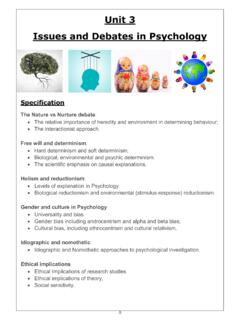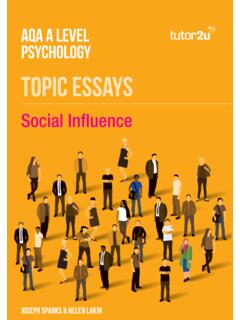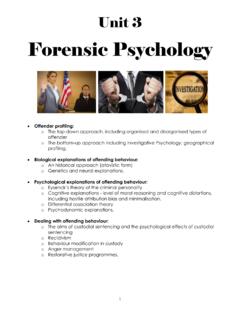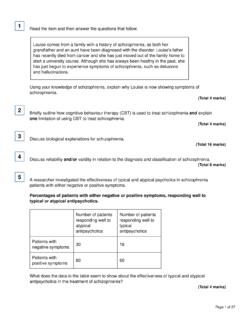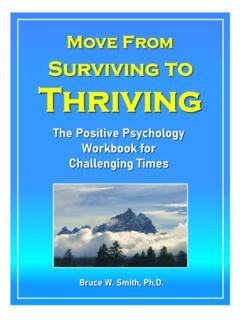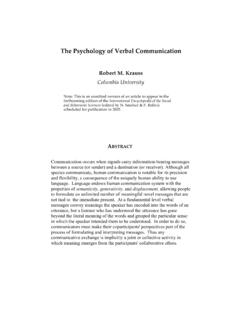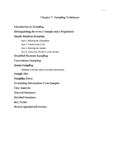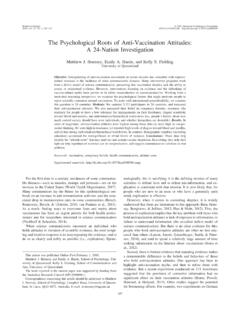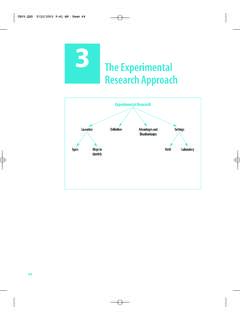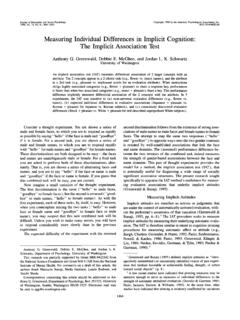Transcription of Research Methods Psychology Pack: Year 1
1 Research Methods Psychology Pack: Year 1. 1. Contents Page Revision Checklist/ Specification Page 3-7. Experimental Methods (Aims, experimental and correlational hypothese, IV/DV ) Page 8-11. Operationalisation Page 8. Experimental Methods : lab and field experiments Page 12. Experimental Methods : Quasi and Natural experiments Page 13. Control of variables Page 14. Reliability and validity Page 15. Experimental design Page 16-17. Non experimental Methods : Self report Interviews & questionnaires (inc. designing) Page 18-21. Non experimental Methods : Observational techniques (inc. designing) Page 22-25. Non experimental Methods : Case studies Page 26. Non experimental Methods : Correlation Page 27-29. Non experimental Methods : Content and Thematic Analysis Page 30.
2 Sampling Page 31-33. Pilot studies and Ethics Page 34-36. Peer Review Page 36-37. Psychology & the economy Page 37. Qualitative & quantitative data Page 38. Primary & secondary data and meta-analysis Page 39. Descriptive Statistics Page 40-42. Presentation & display of data Page 43-46. Mathematical content (Percentages, decimals, fractions, ratios) Page 47-49. Statistical testing: The sign test Page 50-53. Design a study Page 54-55. Practical write ups and Practice exam questions Page 56 +. 2. The Specification Research Methods : Year 1. You will need to be able to demonstrate knowledge and understanding of the following: 1. Research Methods 2. Scientific processes 3. Techniques of data handling and analysis. 4. It is also important that you're aware of their strengths and limitations.
3 Notes? Revised? Methods and techniques Experiments What is a lab experiment? What are the advantages of a lab experiment? What are the disadvantages of lab experiments? What is a field experiment? What are the advantages of a field experiment? What are the disadvantages of field experiments? What is a natural experiment? What are the advantages of a natural experiment? What are the disadvantages of natural experiments? What is a quasi experiment? What are the advantages of a quasi experiment? What are the disadvantages of a quasi experiment? How to design an experiment. 3. Correlational analysis What is a correlational study? What is the difference between correlations and experiments What is a positive/negative correlation?
4 What are the disadvantages of a correlational study? What are the disadvantages of correlational study? How to design a correlation Observational techniques What is an observational study? What is a naturalistic observation? (+advantages and disadvantages). What is a controlled observation? (+advantages and Disadvantages). What is a covert and overt observation? (+ advantages and disadvantages). What is a participant and non-participant observation? (+ advantages and disadvantages). How to design an observation Self report techniques What is a questionnaire? (+ advantages and disadvantages). What is an interview? What is a structured interview? (+ advantages and disadvantages). What is an unstructured interview? (+ advantages and disadvantages).
5 How to design questionnaires and interviews. Case studies What is a case study? What are the advantages of case studies? What are the disadvantages of case studies? Content analysis What is a content analysis? What are the advantages of a content analysis? What are the disadvantages of a content analysis? 4. Investigation design Aims -stating aims, -difference between aims and hypotheses Hypotheses - Directional/one tailed hypothesis - Non-directional/ two tailed hypothesis - Null hypothesis - Operationalised hypotheses Sampling - The difference between population and sample - Opportunity sample (+advantages and disadvantages). - Random sample (+advantages and disadvantages). - Volunteer sample (+advantages and disadvantages).
6 - Systematic sample(+advantages and disadvantages). - Stratified sample (+advantages and disadvantages). Pilot studies and the aims of pilot studies Experimental design - Independent groups (+advantages and disadvantages). - Repeated measures (+advantages and disadvantages). - Matched pairs (+advantages and disadvantages). Observational design - Time and event sampling (+ advantages and disadvantages). - Behavioural categories? (you must be able to create operationalised behavioural categories). Questionnaire construction - The use of open and closed questions (+advantages and disadvantages). Designing interviews Variables -Independent variable -Dependent variable -Co-variables (correlation). - Operationalisation of variables -Extraneous variables (and how they can be controlled).
7 -Confounding variables (and how they can be controlled). 5. Control - random allocation & how to do this - counterbalancing & how to do this - randomisation & how to do this - standardisation & how to do this Demand characteristics and investigator effects Ethics - the role of BPS guidelines - ethical issues in the design and conduct of psychological studies - dealing with ethical issues in Research The implication of psychological Research for the economy Reliability -what is reliability? - definition of inter-rater reliability and how this is used to assess the reliability of observations Validity - what is validity? - types of validity internal and external (ecological, temporal, population). Data handling and analysis Quantitative and qualitative data - the distinction between these data collection techniques Primary and secondary data (+ advantages and disadvantages).
8 -including meta-analysis (+advantages and disadvantages). Descriptive statistics Measures of central tendency - Mean (+ advantages and disadvantages) and calculation - Mode (+ advantages and disadvantages) and calculation - Median (+ advantages and disadvantages) and calculation Measures of dispersion - Range (+ advantages and disadvantages) and calculation - Standard Deviation (+ advantages and disadvantages). Calculation of percentages Positive, negative and zero correlations Presentation and display of quantitative data -graphs 6. -tables -scattergrams -bar charts - histograms Distributions -normal and skewed distributions -characteristics of normal and skewed distributions Analysis and interpretation of correlation, correlation co-efficients Qualitative data analysis - content analysis and thematic analysis Introduction to statistical testing - calculating of the sign test - interpreting the significance of the sign test Introduction Psychology is often defined as the science of mind and behaviour'.
9 In order for Psychology to be considered a science (and therefore a legitimate academic subject) it has to follow the rules of science. This means that psychologists can't just come up with ideas that they believe are true, or essentially opinions. Psychologists aim to gather evidence about behaviour whilst trying to remain objective and free from bias (personal views). One way this is achieved is through using the scientific method. The scientific method is a way of gathering evidence in an orderly, structured manner that can enable psychologists to develop theories and draw conclusions about behaviour. Research Methods are a vital component of studying Psychology and this pack will take you through the various Methods that are used within Psychological Research , what kind of data can be gathered and how the data is analysed.
10 Get ready for the journey! 7. A variable is anything that can Research Methods vary, changed or be changed, such as memory, attention, time Experimental Methods taken to perform a task, etc. Psychologists use the experimental method to identify the "effect" one variable has on other variables. In other words .does one variable "cause" other variables to change. This is called cause and effect. Being able to conduct Research that establishes cause and effect is a key feature of scientific Research . However establishing cause and effect is not easy and requires researchers to conduct studies that not only follow the scientific method, but also classify as "true experiments". In a true experiment, there must be a control condition and an experimental condition and participants must be randomly assigned to these conditions.

